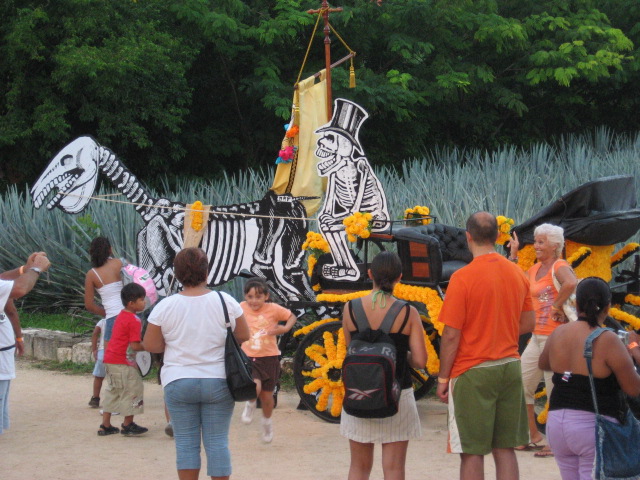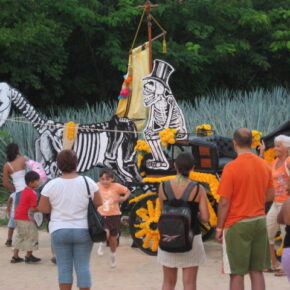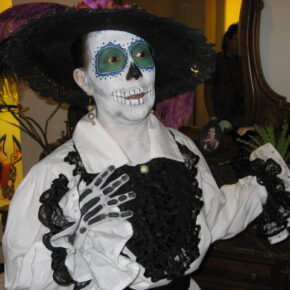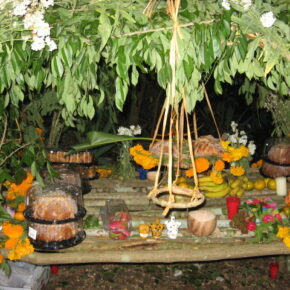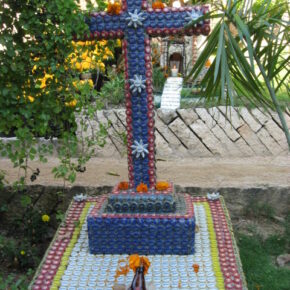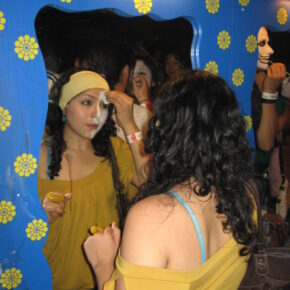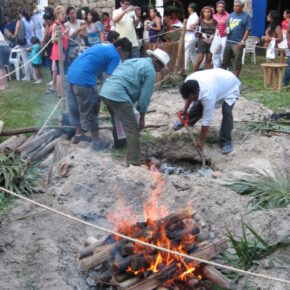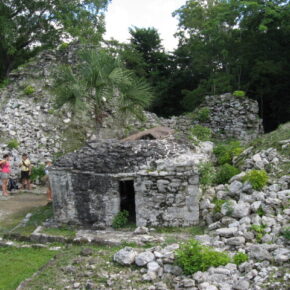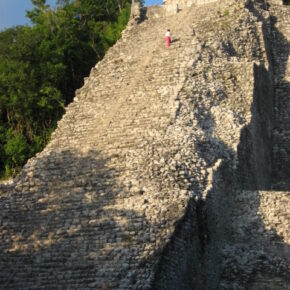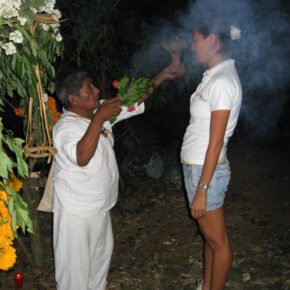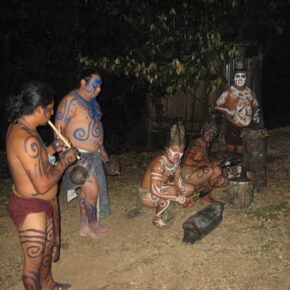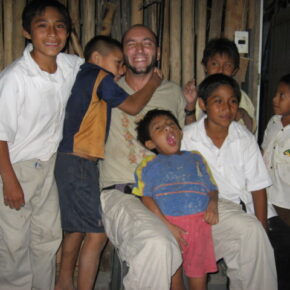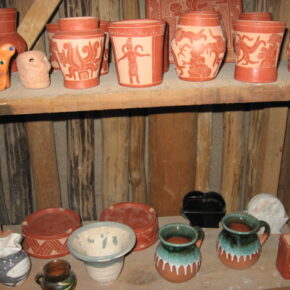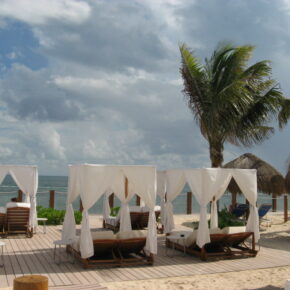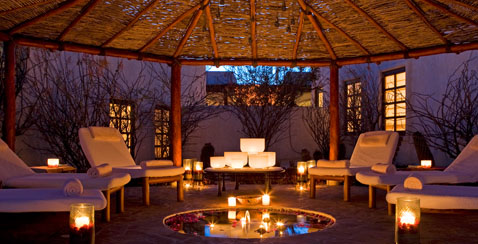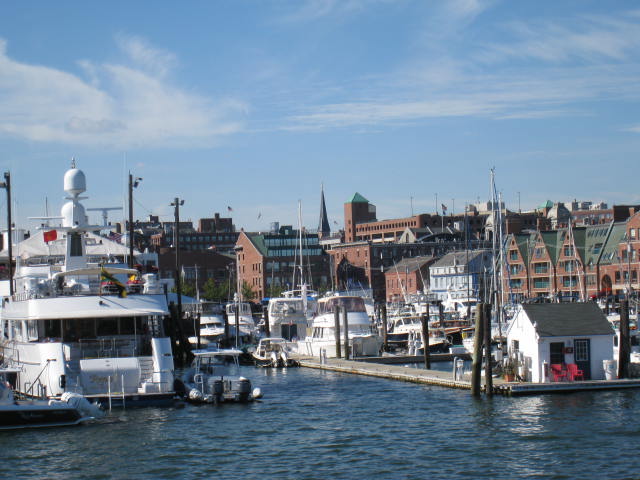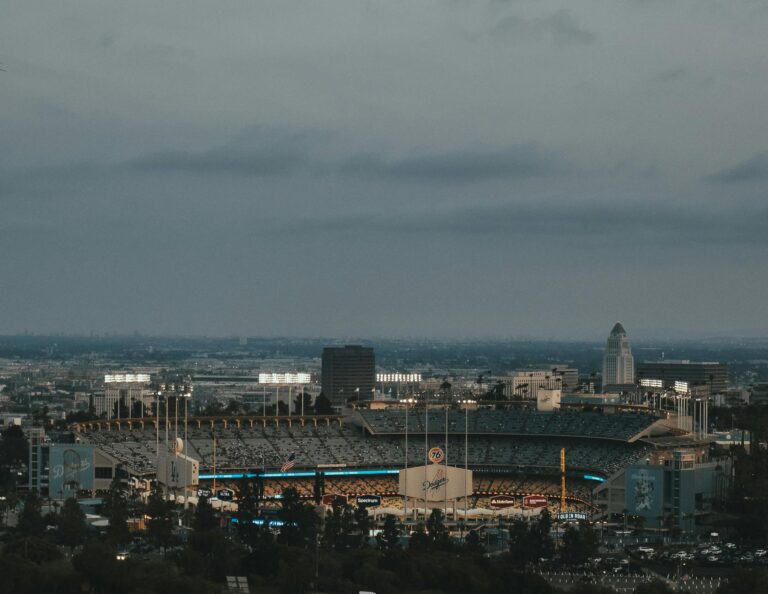Riviera Maya: I See Dead People
I’ve always thought that Día de los Muertos (Day of the Dead) seemed like a macabre, scary, downright depressing holiday, so I was not really looking forward to my “Life and Death” press trip to Riviera Maya. Boy, was I ever wrong. I quickly found that death and some serious partying go hand in skeletal hand here.
The people of Mexico eagerly await November 1st, All Saint’s Day, and November 2nd, All Soul’s Day, when the souls of the dead return for a joyful family reunion, filled with special food, drinks and fond memories.
Day of the Dead is an important family event. Everyone works together to clean the gravesite as well as build a home altar (ofrendas) colorfully decorated with candles, photos, flowers, comically ghoulish paper-mache skeletons and sugar-candy skulls as well as the deceased’s favorite food and drink. One local girl told me with a giggle, that she always made sure to include a big bottle of tequila-which was her grandpa’s beverage of choice. She said it is also important to arrange a bright orange trail of marigolds (the flower of the dead) in front of the altar, as well as lighted candles and fragrant baked breads to help guide the spirits home to their loved ones.
One of the splashiest celebrations can be found at Rivera Maya’s Xcaret cultural theme park, when they host their annual Festival de la Vida y la Muerte, “Festival of Life and Death”, which is recognized as a “Masterpiece of Oral and Intangible Cultural heritage” by UNESCO. The event runs from October 30th to November 2nd, and is a crazy quilt of live theater, concerts, colorful costumes, handicrafts, parades, and a wonderful “graveyard” filled with the replicas of the most humorous altars that are actually found in neighboring cemeteries, as well as many other symbolic rituals. Before you get started, take advantage of the make-up stands (the locals are happy to offer beauty tips) to paint your own black and white Day of the Dead face.
Come hungry so you can taste your way through the many unique food stalls set up by Mayan villagers. Traditional faves include handmade corn tamales baked in a stone oven, mucbil pollo, a traditional Day of the Dead dish of chicken, achiote and tamales wrapped in banana leaves. These are then baked for many hours in the communal fire pit, followed by a rich, spicy Mayan hot chocolate for dessert.
Side Trips:
Two highly recommended side trips that are not only fun but also help support the local villagers are:
Muyil Archelogical site
While not the oldest, biggest or even the best preserved, the ruins of Muyil offers the most fascinating tour guides found at the non-profit Community Tours Sian Ka’An, the only authentic Mayan company in the area. Sian Ka’an, Mayan for “Where The Sky Is Born,” was one of the first established Biosphere Reserve in Mexico, and is a UNESCO World Heritage site. They offer a variety of tours including snorkeling, floating, birding, fly-fishing, etc.
Our naturalist guide, Alberto Cen Caamal (is fluent in three languages, is an awarding winning furniture designer as well as an avid birder and conservationist) gave us a most welcome summary of centuries of Mayan history. He patiently answered all our questions (and we really pushed the boundaries of “there is no such thing as a stupid question”) fascinating us with stories about ancestral shaman and later divulged that he actually had seen one elder shape-shift into an eagle. (When queried, he said it took about 15 minutes from beginning to end.) We loved out jungle tour, where Alberto pointed out all sorts of interesting flora and fauna. He showed us the tree where the special melipona bees lived, a chewing gum tree, vines to wrap around you that would draw out snake venom if bitten, even a Hobo tree that can used to make tortillas. If they ever film a Survivors show here, he’d win for sure!
Community Tours Sian Ka’an was created to help fund conservation projects and provide a means for the local people to participate in the eco-tourism industry. One of their main goals is to keep the old ways and traditions alive, so they are providing extensive cultural training programs in areas such as midwifery, hieroglyphics, food preserving, shamanism, arts and crafts, etc. Their new projects include a birding program, a museum and botanical garden.
Cobà – A day in the life of a Mayan
The best way to visit Cobà, the largest and oldest Mayan Ruins site in the Yucatan is to arrange a sunset tour where if you climb the 138 ft. Nohoch Mul, the highest pyramid in the Yucatan Peninsula, you’ll be rewarded with the spectacularly lush view of the surrounding Mayan jungle dotted with temples were known by Ancient Mayans as “Houses of the Gods”.
For a real Mayan community experience have The Mayan Express make all your arrangements which includes exploring the ruins by bicycle, climbing the pyramid, visiting the local village of Coba where you’ll enjoy an authentic Mayan feast cooked by the village women, ending with a dramatic theatrical experience held deep in a torch lit cenote (a deep, cavernous sinkhole).
Because we visited on Day of the Dead, it was a uniquely wonderful experience. We were allowed to join the villagers who watched the local shaman, a kindly looking older man dressed in a pristine white cotton tunic and pants, perform many rituals including blessing the altar, the pib (fire pit) for the mucbil pollo, while accompanied by musicians wearing feathered headdresses, loincloths, with painted faces and bodies, playing instruments made from wood, stone and dried animal hides.
He then blessed each of us, softly chanting Mayan prayers as he waved burning sweet herbs around our bodies.
However, the most inspiring part of the day was meeting Agustin Villalba, beloved founder of The Mayan Express. Agustin is a generous young Argentinean who fell in love with the people of Coba and has made it his mission to keep the village alive. He created a ceramic school where he teaches the children the ancient techniques of Mayan pottery making and glazing. You’re encouraged to join them for a pottery class, though be forewarned, it’s quite a humbling experience to see these youngsters create some amazingly intricate works of art, while our group only managed to produce a few lopsided ashtrays. Any money raised from selling the pottery is used to help the villagers pay for medicine and schooling for the children.
Agustin, who lives in a village deep in the jungle without any electricity and few creature comforts, beams when he talks about his future plans of creating a cultural co-op for the women.
“People are what make-up a place – not just its geography,” he explains. “If the villagers can’t make a living here they’ll be forced to move to the cities to try and get work in hotels or restaurants, and if that happens, Mayan traditions will die.”
After we bought a few pieces of pottery he said most eloquently, “The branches of the trees may be broken but the roots are still here. We want to thank you for helping us keep our culture alive.”
If you go:
Riviera Maya, accessed by flights to/from Cancun, extends 81 miles from Puerto Morelos south to Tulum. For more information visit www.rivieramaya.com
Where to stay:
Ocean Maya owned by Barcelona’s H10 hotel group, is hard at work on the final renovations of the 33 villas (eight rooms each) which will switch over to an adults- only all inclusive resort May 1, 2011.
Highlights: Lush tropical gardens surround each villa for a feeling of intimacy. Start your day with a steaming cappuccino at the Euro-chic Mike’s Coffee shop- loved their copper ceiling fans. Favorite dining spot was the Japanese restaurant Yookoso with Teppanyaki grill–the chef there was flipping veggies and shrimp with the best of them. The DeSpacio Spa and Fitness Center offers a bright new space to work off those buffet breakies.
Discover more from Tango Diva
Subscribe to get the latest posts sent to your email.
